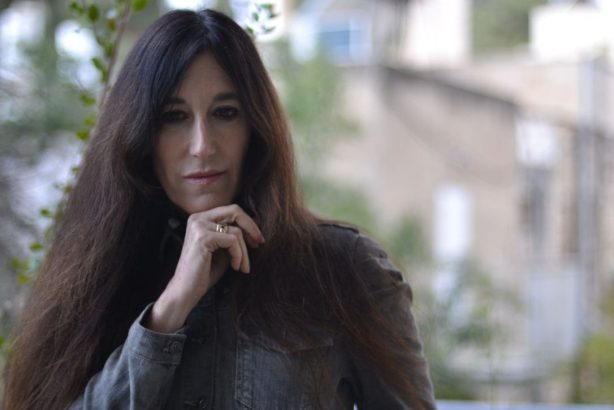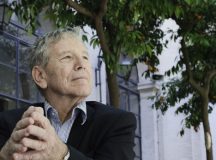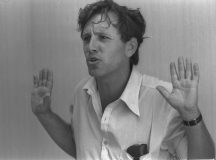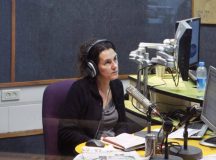The translation of Zeruya Shalev’s 2015 novel Pain should be the moment she assumes ‘her rightful place in the English-speaking world’s literary imagination alongside Amos Oz, David Grossman, and Etgar Keret’, proposes Liam Hoare.
An offhand remark and the pain was back. ‘Remember today’s date?’ Iris’s husband, Mickey, says to her one morning in the opening scene of Zeruya Shalev’s latest novel, Pain (2015, trans. Sondra Silverston). And with that, Iris’s memories of nearly being killed in a suicide bombing well up inside her. ‘Or did she remember first,’ Shalev questions, ‘and then the pain came back?’:
Because she has never forgotten, so it wasn’t actually remembering, but existing totally in that burning moment, in the dawning recognition of the cataclysm, in the ghostly storm of panic, the solemn inertness of silence: no bird sang, no hawk soared, no bull roared, no ministering angels spoke holy words, the sea did not roil, people did not speak—the world was utterly still.
It was in 2004 during the Second Intifada that Shalev, while returning to her home in Jerusalem, was injured by a bomb that exploded in a passing bus. She was confined to her bed for six months, only returning to her desk to write again when she recovered and waiting another ten years to turn those experiences into literature. In Pain, Shalev takes that physical trauma, imposes it upon Iris, and then interweaves it with the character’s own emotional suffering: her unfulfilling and joyless marriage; her resumption of a passionate affair with a man who burned her long ago; her daughter’s possession by an older man; and her attempts to mend her broken family.
Speaking at Jewish Book Week in 2014, Shalev insisted that writing is not therapy for her but rather for her characters. ‘Normally the characters I create are busy in some sort of crisis and, as a literary therapist, it is my job to help them overcome it.’ Indeed, more important than any biographical underpinning to the character of Iris, Pain develops further the theme that has occupied Shalev since the publication of her debut novel, Dancing, Standing Still, in 1993, while returning to ideas present in 2000’s Husband and Wife: the link between physical and emotional pain, and how that pain eats away at marriages from the inside as well as the people trapped in those unhappy relationships.
Shalev is an ‘extraordinary writer,’ the French crime novelist Leila Slimani has said, one whose ‘style is poetic, luminous, demanding’ and who writes ‘with incredible delicacy and power about family, love and fear.’ Her novels have been translated into more than twenty languages, though it is in France, Italy, and Germany that Shalev has found her most loyal audience, winning the Prix Femina and many other awards in the process. Indeed, her next novel Fate—publication date forthcoming—has already found a French and German translator and publisher, though not yet an English one.
Shalev has yet to assume her rightful place in the English-speaking world’s literary imagination alongside Oz, Grossman, and Etgar Keret. With the publication of Pain, perhaps that ought to change. A poetic writer whose sentences ache with the suffering of her characters, few write better about pain—and about pained and damaged people—than Zeruya Shalev.
1.
Shalev was born in May 1959 in Kvutzat Kinneret, one of Israel’s first kibbutzim founded in 1913 on the shores of the Sea of Galilee. The Shalev family is a storied literary dynasty, its best-known member being her cousin, Meir, whose extensive back catalogue of novels and essays, columns and short stories includes Four Meals (1994) and The Blue Mountain (1988). Meir’s father, Yitzhak, was a Zionist poet whose collections were largely published in the 1950s and -60s. Zeruya’s father, Mordechai, was a teacher of religion and literary critic, while her brother, Aner, is the author of two novels and two collections of short stories.
Shalev was working as a literary editor at Keter Publishing House at the time her first collection of poetry, 1988’s An Easy Target for Snipers, was published by Hakibbutz Hameuchad. It would be Keter, however, that would release her debut novel, Dancing, Standing Still. The moment she became a prose writer was recalled in an essay on the author by the Hebrew literary scholar Avner Holtzman. Shalev, he writes, had been due to have a meeting ‘with an author whose manuscript she had been editing’:
The author was two hours late, and while waiting for him she started scribbling words on a napkin, inspired by a life story she had heard some time before from another woman she had met. The story had struck hard and she immediately appropriated it for her own private store of nightmares. That married woman had decided to follow her lover, thinking her life would not be worth living without him. In order to get her husband’s consent for the divorce, she had to forgo all she had—her house, her belongings, and worst of all, her children. But the love that motivated her to wreck her old home broke not long after. That lover hit her and abandoned her, and she was let down and out, utterly disconnected from life.
The narrative prose began to fill the napkin and after half an hour, ‘ten written pages had burst from within her, uncontrollably and without plan. This continued [during] the following days, in series of creative unplanned bursts and in intensive inner turmoil, bringing her to tears at times, until the completion of the book.’
Holtzman notes of Dancing, Standing Still that it was, in many ways, a failure—at least based on its reception in the Israeli press. For many months after its publication, Shalev was afraid to open the arts supplements, not wishing to read what lurked within their pages. And indeed, it would be another four years until she would publish a follow-up, Love Life (1997), which became the novel that made her career.
Whatever its literary merits and critical reception, Dancing, Standing Still and the manner in which it came into being were indicative of two things that would characterise the rest of her literary work. Both her third novel, Husband and Wife, and particularly Love Life are streams of consciousness written in long, breathless run-on sentences. Her style is, on the one hand, a fine example of content dictating form and must, on the other, be the work of someone for whom thoughts and words flow from the mind to the pen in, to quote Holtzman, creative bursts, uncontrollably and without plan. The sentences in Love Life are breathless and urgent, wise and insightful, sometimes a little crazed, but then again sometimes almost sensual in quality. To give one example:
There were always things there, between my side and his, rifts, tensions, insults, but never betrayal, and I felt the bed divided in two, and I tried to reach out to his side with my hand and the wall blocked me, and I started to cry again, what have you done, what have you done, because even at the times when I couldn’t stand him or our life together, I never believed that I would be unfaithful to him, because more than love what we had was a common fate, and cheating on him seemed like cheating fate.
Dancing, Standing Still not only gave Shalev her style—Yigal Schwartz, founding director of ‘Heksherim’: The Research Institute for Jewish and Israeli Literature and Culture at the Ben-Gurion University of the Negev, has described her novels as ‘works of lamentation’—but also her great themes: love, sex, marriage, and pain. Ya’ara, the protagonist of Love Life, is in a simulacrum of the marriage and, on the book’s first page, meets her father’s boyhood friend, Aryeh Even. His presence in her life is an interruption, a jolt, and for him Ya’ara immediately feels what can only be described as an animal attraction. They rather abruptly begin an affair that Ya’ara compares to swallowing fire, a knowledge that nothing less than an affair would excite her ever again. Aryeh becomes the vehicle for her to escape her marriage but Love Life becomes as well as a novel about lust and obsession; a cautionary tale about the intersection and complication of personal relationships.
Husband and Wife is also a novel about a dead marriage and, as mentioned, the link between physical and emotional pain. When Udi awakes to find himself unable to move most of his body, Na’ama feels ‘the life being drained out of me, gently, drop by drop.’ The relationship is already embittered—his words, Na’ama says, are like stones lobbed in her direction, a ‘gravel of filthy syllables’ that invade her inner self—and she having already entertained the idea of cheating on him previously, this medical crisis begets the novel’s emotional denouement, as their marriage, suffice it to say, turns south. Both expressions of a concentrated and unbroken female gaze, the writing in Love Life and Husband and Wife, with its aphorisms and insights baked into these spun-out, suspenseful sentences, is indeed incredibly powerful.
2.
Dancing, Standing Still, Love Life, and Husband and Wife announced Shalev’s arrival as part of a new literary generation in Israel. In 1993 when her debut novel was published, Israeli literature was dominated by Amos Oz, David Grossman, A.B. Yehoshua, and Aharon Appelfeld (In the English-speaking world, at least, not much has changed.). Oz with Where the Jackals Howl (1965) and Elsewhere, Perhaps (1966) and Yehoshua with Facing the Forests (1968) and Early in the Summer of 1970 (1972) came to prominence with modernist novels full of doubt, fear, and scepticism, written as Yossi Klein Halevi once observed in ‘a spare Hebrew’ on themes like ‘the Palestinian tragedy and the decline of kibbutz idealism,’ thus challenging the writers of 1948 who wrote about the ‘mythic Zionist themes of destruction and rebirth.’
All that is new must at some point become old, and in the 1990s, a melange of young postmodernist writers—many of whom gravitated towards Keter Publishing House and Shalev’s orbit in her role as literary editor—rose up to challenge the orthodoxies about the novel as a medium. These newer writers, Holtzman says, ‘strived individually to break the traditional moulds of prose and the reality structure laid out within it,’ playing with time, voice, language, and sentence structure. Shalev found her house as she was editing a long list of authors from Yoel Hofmann to Eyal Megged (Shalev’s husband) while working on the short-lived but pioneering literary journal Efes Shtayim; novels like Dancing, Standing Still were, then, forged in the crucible of this generational shift in Israeli literature.
Her early novels are noteworthy because they also eschewed some of the great themes of Israeli literature Klein Halevi spoke about, namely the Israeli-Palestinian conflict and the Holocaust. ‘Literature is too dear to me,’ Shalev has said, ‘to make it dirty with politics.’ That stance, however, has begun to change (just as her style has cooled off a little in recent years). Her stories of women trapped by and in dissolving, damaging relationships now take place in settings specific to Israel or are touched by the political context. This not only applies to Pain, which brings in the matter of suicide bombing, but 2011’s The Remains of Love, a multigenerational novel about death and the relationship between parents and children which, with its kibbutz setting, cannot help but read, so Adam Kirsch deduces, ‘like a kind of parable of Israel itself.’
Her voice, themes, and perspective also connects Shalev with authors ranging from the late Ronit Matalon—whose final novella And the Bride Closed the Door (2016) is published in English this year—with Austria’s Ingeborg Bachmann, the Nobel Prize winner Toni Morrison, and our own Deborah Levy, all of whom write in their own inimitable way about female subjectivity. ‘When a female writer walks a female character in to the centre of her literary enquiry … she will have to find a language that is in part to do with learning how to become a subject rather than a delusion,’ Levy wrote in Things I Don’t Want to Know (2013), ‘and in part to do with unknotting the ways in which she has been put together by the societal system in the first place.’ It is as if Levy were speaking not only for herself but Shalev too.






































